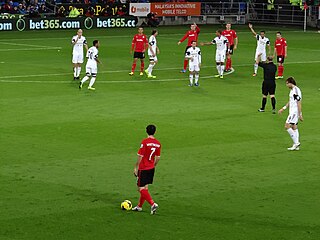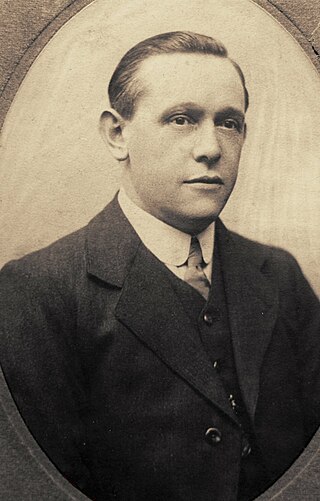
The FAW Welsh Cup, currently known as the JD Welsh Cup for sponsorship reasons, is a knock-out football competition contested annually by teams in the Welsh football league system. It is considered the most prestigious of the cup competitions in domestic Welsh association football.

Wrexham Association Football Club is a professional association football club based in Wrexham, Wales. Formed in 1864, it is the oldest club in Wales and the third-oldest professional association football team in the world. They compete in EFL League One, the third level of the English football league system.

Swansea City Association Football Club is a Welsh professional football club based in Swansea, Wales. It competes in the Championship, the second tier of English football. Swansea have played their home matches at the Swansea.com Stadium since 2005, having previously played at the Vetch Field since the club was founded.

Ammanford is a town and community in Carmarthenshire, Wales, with a population of 5,411 at the 2011 census. It is a former coal mining town. The built-up area had a population of 7,945.

Ninian Park was a football stadium in the Leckwith area of Cardiff, Wales, that was the home of Cardiff City F.C. for 99 years. Opened in 1910 with a single wooden stand, it underwent numerous renovations during its lifespan and hosted fixtures with over 60,000 spectators in attendance. At the time of its closure in 2009, it had a capacity of 21,508.

Newport Stadium, also known as Spytty Park, is an association football, rugby and athletics stadium in Newport, South Wales. It is the home of Gwalia United FC, Newport City Football Club, Newport RFC and Newport Harriers Athletic Club. It was previously also used for home matches by Newport County and Albion Rovers football clubs. Newport County continue to use the stadium as a base for youth teams and senior squad training.

The Swansea.com Stadium is an all-seated multi-use sports stadium and conferencing venue located in the Landore area of Swansea, Wales, hosting both rugby union and football. The stadium opened in 2005 and was named the Liberty Stadium. It had an opening capacity of 20,750, making it the largest purpose-built venue in Swansea; minor layout changes have since increased this to 21,088.

The Racecourse Ground, known for sponsorship reasons as the STōK Cae Ras, is a football stadium in Wrexham, Wales. It is the home of Wrexham A.F.C.

St Helen's Rugby and Cricket Ground, commonly known simply as St Helens Ground, is a sports venue in Swansea, Wales, owned and operated by the City and County of Swansea Council. Used mainly for rugby union and cricket, it has been the home ground of Swansea RFC and Swansea Cricket Club since it opened in 1873.
The 1924–25 British Home Championship was a football tournament played between the British Home Nations during the 1924–25 season. It was one of six tournaments in seven years won by the strong Scottish team of the early 1920s, and was achieved with a whitewash of all three rivals, including England in the deciding game in Glasgow.

The South Wales derby is a local derby between Welsh association football clubs Cardiff City and Swansea City. The fixture has been described by The Independent as one of the fiercest rivalries in British football. Although based in Wales, both clubs play in the English football league system and have won English honours: Cardiff the FA Cup in 1927 and Swansea the Football League Cup in 2013.

Frederick Richard Buck, better known as Fred Buck, was an English footballer who played as an inside forward and centre half. He played in the Football League for West Bromwich Albion and Liverpool, and the Southern League for Plymouth Argyle and Swansea Town.
Samuel Richard Jepp was an English professional footballer who played in various defence positions for Southampton and Swansea Town in the early twentieth century.

The Wales national football team represents Wales in international association football. The team played their first match in March 1876 against Scotland before hosting their first home match the following year against the same opponent. The location selected for the fixture was the Racecourse Ground in Wrexham, the world's oldest international football ground still in use. The ground hosted all of Wales's matches until 1890, when a game was played against Ireland in the English border town of Shrewsbury. Wales played matches in several parts of the country, including Bangor, Cardiff, and Swansea over the following two decades.

North Wales Crusaders is a professional rugby league club based in Colwyn Bay, Wales. They are the successors to the former Super League club Crusaders Rugby League. Crusaders compete in Betfred League 1, the third tier of English rugby league. Until the end of 2016 they played their home games at the Racecourse Ground in Wrexham. From 2017 to 2020 they were based at the Queensway Stadium in Wrexham, but also played several games at Hare Lane in Chester. In 2021 the club moved to the Eirias Stadium in Colwyn Bay.
During the 1981–82 English football season, Swansea City A.F.C. competed in the Football League First Division, following promotion from the Second Division. It was their debut season in the English top flight and the first season in which a Welsh club was part of the top English league since arch-rivals Cardiff City were relegated at the end of 1961–62.
The 1912–13 season was the first season in which Swansea Town took part in league and cup football. The club was elected to Division Two of the Southern Football League.

Swansea City is a Welsh football club based in the city of Swansea, which competes in the Premier League. The club was founded in 1912 as Swansea Town, and competed in the Southern Football League until they were elected to The Football League in 1920, as founders of the Third Division. The club changed its name in 1969, when it adopted the name Swansea City to reflect Swansea's new status as a city. In 2010, after winning a Championship Play-off final, Swansea became the first Welsh team to compete in the Premier League.



















